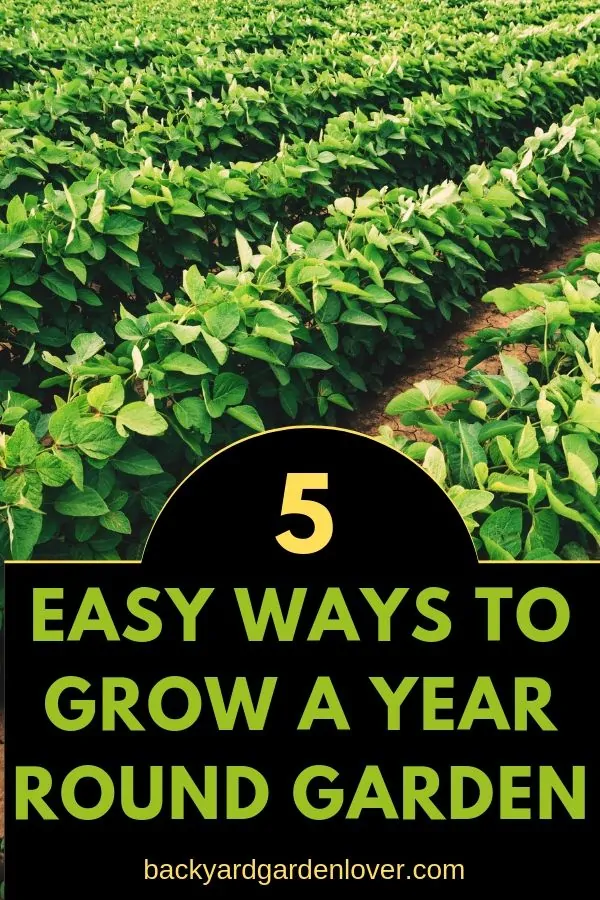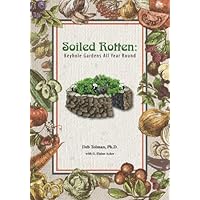Growing a year round garden may sound like daunting activity given the ever-changing weather patterns and the extra work. But that is not the case. The beginning of fall frost doesn’t have to be the end of eating garden-fresh veggies.

Extending your harvest throughout the entire year is easier than you think and comes with numerous benefits. So, how can you achieve year-round produce? Kyle from Green Coast is sharing how to extend gardening season through the year.
Several techniques can help you achieve a year-round garden target. If you implement these tactics, you will be among the gardeners around the US who enjoy fresh foods all-year-round. You might be surprised that you don’t have to rely on indoor or vertical farming to do so. I’ll highlight exactly how.
How to Grow Your Own Food 365 Days a Year Grow Nutrient-Dense, Soil-Sprouted Greens in Less Than 10 days
Grow Nutrient-Dense, Soil-Sprouted Greens in Less Than 10 days Growing Vegetables and Herbs, Inside or Outside
Growing Vegetables and Herbs, Inside or Outside How to Design and Build a Net-Zero Energy Greenhouse
How to Design and Build a Net-Zero Energy Greenhouse Soiled Rotten: Keyhole Gardens All Year Round
Soiled Rotten: Keyhole Gardens All Year Round Polytunnels for All Seasons and All Climates
Polytunnels for All Seasons and All Climates
Five Ways To Build A Year Round Garden
1. Plan for year-round harvests
Plan carefully to make the most of your garden all-year-round. Garden planning and timing is vital and can help you maximize both your space and time.
Spend a little time planning what you can grow and when, what can yield a harvest at any time of the year and how you will do it. Take into consideration the different climatic conditions and the challenges that each season brings. That will help you plan well for each season. You’ll keep growing more in each season, whether it’s a plunging freeze of winter or the searing heat of summer.
Also, you can make use of apps that have been developed to enable you to plan for yearly produce. They can help you to know the crop variety to grow in different seasons, specific dates, and the gaps where earlier crops have been harvested during particular months.
2. Choose the right crop varieties for growing in different seasons
Sometimes, you’ll need to select cool seasonal plants that are resistant to bolt, especially during the spring season when there are hotter and longer days. During the fall, when the days are colder and shorter, you can choose the cold-hardy crop varieties.
For example, Growing ‘Winter Density’ or Rouge D’hiver’ in winter is good because you can harvest them under tunnels. But, growing lettuce in fall is not a good idea because it’s not a cold-hardy plant.
During springtime, you can plant bolt-resistant crop varieties that can withstand the increasing temperatures.
The cool-season vegetables may not be able to withstand the hard and light frosts. However, they thrive during the cool temperatures. Some of the Cool Season crops include:
- beets
- salsify
- cauliflower
- Chinese cabbage
- collards
- fava beans
- garlic
- radishes
- and more
The cold-hardy vegetables, on the other hand, can withstand the light and hard freezes and may even hideaway under the snow for a spring harvest. However, this is often based on your climate and the growing zone. Some of the root veggies are even sweeter after the heavy frost.
For example, if you grow carrots, parsnips, beets, and turnips, you can harvest them in fall. You can harvest even crops that remained in the ground throughout winter and sprouted in spring.
Some of the cold-hardy crops include:
- turnips
- broccoli
- arugula
- cabbage
- spinach
- beets
- carrots
- sprouts
- collards
- kohlrabi
- kale
- lettuce
- rutabagas
- leeks
- mustard
- and more
Grow crops with season extenders
Mr.Garden 24Pack Wall Water Season Extender Water Filled Garden Teepee for Frost Snow Protection, Red You can stretch the season for a variety of crops using season extenders. While several plants can handle snow, frosts and harder freezers, some can’t. You can benefit from the use of season extenders as long as you choose the right crops.
You can stretch the season for a variety of crops using season extenders. While several plants can handle snow, frosts and harder freezers, some can’t. You can benefit from the use of season extenders as long as you choose the right crops.
For most gardeners, the plants’ growth slows down and the season comes to an end mid to late fall when the first frost occurs. However, that doesn’t have to be the end of your harvest. You can offer a little protection to your crops for them to go on for a little longer.
For example, you can make use of row covers, cold frames, or low tunnels to provide your crops with an additional shelter and warmth. Crops such as peppers, tomatoes, and cucumbers ripen continually when they are offered protection from frost. Even the late starters can catch up and produce a good harvest if offered protection. Offering protection to the tender crops can keep them going even when a favorable season ends.
Consider some of the tips that you need to know when building & using season extenders:
- Make use of unheated winter greenhouse to grow your crops
- Try using a frost cloth (or row cover) in your garden
- Make use of venting
- Use low tunnels and hoop houses in the garden
- Add a poly-tunnel over raised garden beds
- Use transplants and restore the soil
Sow quick-maturing varieties to spread your harvests throughout the year
Sowing quick-maturing crops can help you spread your harvest to achieve a year-round garden. Sow fast-growing crop varieties with staggering dates throughout the year. This helps ensure that there is a constant succession of plants and no bare grounds exists which can attract weeds.
You can select a combination of crop varieties that can cover all seasons from January to December. That will maximize the length of your yields and the length of the period to enjoy each crop.
Some of the super speedy plants to grow include:
- radishes which can take 25 days from sowing to harvest
- salad leaves that take 21 days and spinach that takes 30 days
- carrots and bush beans also take a relatively short period of fewer than two months from sowing time to harvesting
Plant your crops in succession
Planting a succession crop can also help build a year-round garden. Succession planting involves different planting methods that help increase the availability of vegetables during a particular growing season by making efficient use of timing and space.
Approaches of succession planting include growing
- two or more crops in succession
- same plants in timed intervals
- two or more crops simultaneously
Succession crops can consist of winter and autumn-maturing vegetables which have been transplanted from midsummer onward.
Also, it consists of the plants that are ideal for storage, including main crop celeriac and carrot, as well as quick-growing crops such as bush beans and bulb fennel, which mature quickly.
Have a ready nursery, cold frame or greenhouse to enable you to raise vegetables from seeds and get them ready for planting every time there is a gap in your garden. This way you avoid wasting any growing season or period. Use a grey water system to limit your water usage and increase efficiency.
Conclusion
If you want to achieve a year-round garden, watch your timing, selecting the crop variety and using season extenders. Building a year-round garden will ensure that you are getting fresh harvest throughout the year from January to December. Consider putting these tips into practice and be consistent with your actions to achieve color in your garden all-year-round.
Author Bio: Kyle is a contributor for Green Coast and has a strong passion for sustainability. Green Coast is a renewable energy and green living community focused on helping others live a better, greener life. We believe that energy and green living has become far too complex, so we created a number of different guides to build a sustainable foundation. You can follow updates on Facebook and Twitter.

Adriana Copaceanu is a passionate nature lover living in the country on her dream property where she grows vegetables, lavender, and wildflowers that she shares with the wildlife they attract. When she's not in the garden, she loves spending time with her chickens and planning her next nature project. Check out her books below:
How to Grow Lavender for Fun and Profit: Lessons Learned from Planting Three Hundred Lavender Plants








How To Grow Delicious Brassica Vegetables
Thursday 24th of December 2020
[…] Growing brassicas is not difficult, but you do need to provide good, nitrogen-rich soil and be attentive to pests. Some brassicas, such as kale, can provide you with greens year-round. When the harvest comes in for each crop, enjoy your bounty. If you learn to store your vegetables, you can eat from your garden all year. […]
How To Create A Garden For The Birds
Tuesday 1st of December 2020
[…] have you ever thought about planting a year round garden for the birds? There are many shrubs and trees that provide food for all four seasons. Let’s […]
10 Best YouTube Gardening Channels For Garden Lovers
Tuesday 1st of December 2020
[…] to learn how to grow a garden all year long? This channel will show you that your garden can be a space that grows your foods at any time […]
Easy Vegetables To Grow In Pots - Great For Small Spaces
Sunday 13th of October 2019
[…] And when the weather cools, you can bring these indoors for an extended season. […]
How To Make Organic Compost At Home For Better Vegetables
Thursday 26th of September 2019
[…] a certified organic grower is not practical for most home vegetable gardeners as it requires soil tests to assure the organic […]